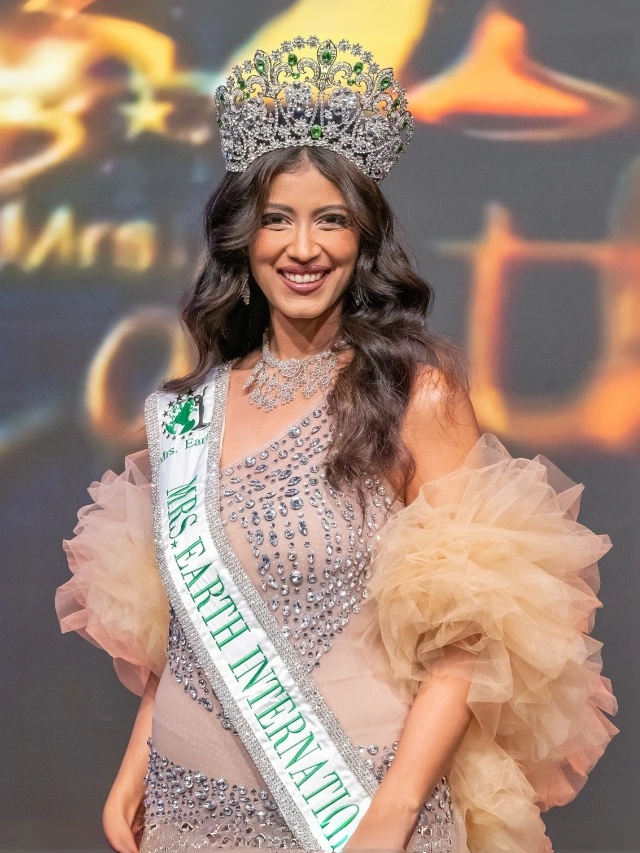Mira Nair
Mira Nair made history as the first female director to win the prestigious Golden Lion award at the Venice Film Festival for “Monsoon Wedding” in 2001. She was born in Rourkela, India, on October 15, 1957. Her experience from studying at Delhi and Harvard Universities to gaining international acclaim shows a remarkable career that spans over three decades.
Her most important achievements started with “Salaam Bombay!” (1988), which won the Caméra d’Or and earned an Academy Award nomination for Best Foreign Language Film. She created critically acclaimed movies like “Mississippi Masala” (1991) and “The Namesake” (2006), and showed exceptional commercial success with “Monsoon Wedding” that earned over $30 million worldwide.
CEO’s | Actors | Politicians | Sports Stars
Her steadfast dedication to social causes stands out. She used the profits from “Salaam Bombay!” to establish the Salaam Baalak Trust in 1998, which supports street children in India. She also founded the Maisha Film Lab in 2005 to help emerging East African filmmakers grow. The Indian government recognized her contributions to cinema and society with the Padma Bhushan in 2012, India’s second-highest civilian honor.

Early Life and Education of Mira Nair
Childhood in Rourkela and Bhubaneswar
Family Roots: Mira Nair was born on October 15, 1957, in Rourkela, Orissa (now Odisha), India, to a Malayali Christian family from Kerala. Her father, Amrit Lal Nair, worked as an Indian Administrative Service officer, and her mother, Parveen Nair, devoted herself to children’s causes as a social worker. Her parents’ commitment to public service and social awareness left a lasting impact on her filmmaking style.
Early Environment: Mira lived in Bhubaneswar until she turned 18, alongside her two older brothers. Her father’s civil service career gave her rich cultural experiences that shaped her future work as a filmmaker. She went to a local convent school in Bhubaneswar, where she first showed a natural talent for storytelling and performance.
Cultural Foundation: Mira’s early years were filled with eastern India’s cultural richness. Her father’s job meant the family moved often, which helped her become adaptable and culturally aware. Her childhood in Odisha gave her the groundwork to create films that would later connect different cultures and identities.
Academic experience from Delhi to Harvard
Shimla Education: Mira’s first taste of independence came at 13 when she left for Loreto Convent Tara Hall in Shimla, an Irish-Catholic missionary school. Her time at Loreto sparked a love for English literature that improved her storytelling skills.
University Studies: After Shimla, Mira studied sociology at Miranda House, Delhi University. She became deeply involved in theater under expatriate British director Barry John, who greatly influenced her artistic growth. She once joked, “In all the plays I always got to play the boy’s mother while my friend Lillete Dubey got to play the sexy girl”.
Harvard Experience: A life-changing moment came at 19 when Mira received full scholarships to both Cambridge and Harvard Universities. She chose Harvard, making her first trip abroad. She moved from Delhi University to Harvard in 1976 and focused on Visual and Environmental Studies, particularly documentary filmmaking. Harvard opened her eyes to global ideas that expanded her artistic vision.
Academic Achievement: Mira completed her Harvard degree in 1979, equipped with technical and theoretical knowledge for her future work. Her unique blend of sociology, visual arts, and filmmaking studies created the perfect mix for her storytelling style that combined cultural analysis with visual creativity.
Original interest in acting and sociology
Theatrical Beginnings: Mira started as an passionate actor before becoming a filmmaker. At sixteen, she worked in protest theater in Calcutta with famous Bengali playwright Badal Sircar. This early work with political theater shaped her documentaries’ social awareness.
Artistic Development: Mira’s creative focus changed during her Harvard years. She first wanted to act at the Loeb Theater, but her packed schedule pushed her in a new direction. A summer course at Harvard introduced her to photography, and she remembered, “It was wonderful in the sense that it taught me how to see, literally how to frame”.
Finding Her Medium: Photography didn’t quite fit Mira’s outgoing nature. She explained, “My personality was much more about engagement with people rather than observing them”. This led her to take a film class at MIT with cinema verité pioneer Richard Leacock, where she learned to use the camera “to engage in life”.
First Documentary: Mira’s Harvard education ended with her senior thesis “Jama Masjid Street Journal” (1979), which looked at Muslim life in Old Delhi. She created this project using equipment from documentarian and Harvard anthropologist Robert Gardner. This first work laid the groundwork for her remarkable career in film, where she consistently explores cultural identity and social issues.
From Documentaries to Feature Films
First works: Jama Masjid Street Journal and India Cabaret
Cinema Roots: Mira Nair started her filmmaking experience with a black-and-white thesis film at Harvard. Her “Jama Masjid Street Journal” (1979) captured life on Old Delhi’s streets through casual conversations with locals. She created this 18-minute student film as a silent documentary but added narration after others suggested it – a choice she wished she hadn’t made.
Documentary Progress: Nair’s next project after Harvard was “So Far from India” (1982). The film tracked an Indian newspaper dealer in New York while his pregnant wife waited back home. This 52-minute documentary earned Best Documentary awards at both the American Film Festival and New York’s Global Village Film Festival. These accolades helped establish her unique documentary style.
Bold Explorations: “India Cabaret” (1985) stands out as Nair’s most daring early work. The film took an honest look at female strippers in Bombay and showed the divide between what society called “good” and “bad” women. She spent four months living with these dancers despite her family’s disapproval. The film showed how these women dealt with money, marriage, family life, and society’s harsh judgment through real conversations.
Why she changed to fiction storytelling
Artistic Control: After making several well-received documentaries, Nair felt drawn to narrative films. “I wanted more control of the story,” she said. Her cinema verité training under D.A. Pennebaker and Richard Leacock had started to feel restrictive.
Audience Considerations: She grew frustrated waiting for people to watch her documentaries. “Documentaries were hardly ever seen” during that period. This reality led her to fiction as a way to reach more viewers while keeping her unique storytelling style.
Creative Growth: Her shift also showed her artistic development. While filming “India Cabaret,” she found unexpected emotional depth in her subjects’ real lives and their everyday language. This insight inspired her to create fiction that could capture such authenticity while offering more structured storytelling.
The making of Salaam Bombay!
Collaborative Genesis: Nair and her friend Sooni Taraporevala wrote “Salaam Bombay!” together in 1983. The story came from her documentary work – specifically her observations of young street boys working in tea shops near the cabaret clubs.
Authentic Approach: Rather than work with professional child actors, Nair picked actual street children to tell their stories. She ran workshops with these kids and cast many in main roles. This unique method combined her documentary background with fiction filmmaking, creating what she called “an amalgam” of her theater and documentary training.
Technical Innovation: The film featured:
- Actual Mumbai locations rich with detail
- Documentary cinematographer Sandi Sissel
- Natural sounds and authentic Hindi street slang
- Cinema verité techniques in fiction storytelling
Breakthrough Success: While not a box office hit, “Salaam Bombay!” earned incredible critical praise with over 25 international awards, including the Camera d’Or at Cannes Film Festival. The film became just the second Indian movie after “Mother India” (1957) to get an Academy Award nomination for Best Foreign Language Film. This success established Nair as a major global filmmaker.
Breakthrough Films That Shaped Her Career
Mississippi Masala and interracial narratives
Mira Nair made her mark with her 1991 film “Mississippi Masala,” which took a bold look at interracial relationships in America’s Deep South. The story follows Mina, a young Indian woman whose family fled Uganda during Idi Amin’s regime. She falls in love with Demetrius (Denzel Washington), a Black carpet cleaner in Mississippi.
Nair placed racial hierarchy at the heart of her vision. “I wanted to confront the ‘hierarchy of color’ in America, India, and East Africa,” she explained about the project that grew from her time as an Indian student at Harvard. The film bravely showed prejudices in both communities and highlighted anti-Black racism among Indian immigrants.
The film struck a powerful chord with critics. It earned a standing ovation at the 1992 Sundance Film Festival and won three awards at the Venice Film Festival. Audiences connected deeply with its themes of finding belonging in foreign lands.
Monsoon Wedding and global acclaim
“Monsoon Wedding” (2001) launched Nair from respected indie filmmaker to global director. She made the film with a small crew that included some of her relatives. The movie earned over INR 2531.41 million worldwide and became one of the highest-grossing international films in American box office history.
Nair became the first female director to win the Golden Lion at the Venice Film Festival. Her vibrant portrayal of a Punjabi wedding set the stage to explore family dynamics, arranged marriage, and India’s transition between tradition and globalization.
The film’s creation broke new ground. Nair remembered, “I did not want to go down the assembly line of Tony Award-winning Broadway creators… I wanted to do what we did in the film, which was to go back home to Delhi and to India”. This genuine approach created what critic Roger Ebert called “one of those joyous films that leaps over national boundaries and celebrates universal human nature”.
The Namesake and diasporic identity
“The Namesake” (2006), Nair’s adaptation of Jhumpa Lahiri’s bestselling novel, centers on identity challenges. The film tells the story of Gogol Ganguli, an American-born son of Bengali immigrants, as he finds his way between two cultural worlds. Nair brought her first-generation immigrant experience to the material, which differed from Lahiri’s second-generation outlook.
Nair’s cultural view shaped her adaptation choices. Film scholars noted that “while the novel stresses identity as a fluid notion that always undergoes changes… its film adaptation emphasizes India as the essence of identity that is unchanged, timeless, and stable”. This interpretation reflects Nair’s experience of leaving India as an adult rather than growing up abroad.
Queen of Katwe and Disney collaboration
Nair reached a career milestone when she directed “Queen of Katwe” (2016) for Disney. The biographical film, with a budget of INR 1265.71 million, told the inspiring story of Ugandan chess prodigy Phiona Mutesi who rose from extreme poverty to become a chess grandmaster.
The film strengthened Nair’s bond with Africa, where she has a home. She cast Lupita Nyong’o and David Oyelowo, calling them her “first choices” for their roles. Despite studio backing, Nair kept her unique style. She described it as “a radical film for Disney in many ways…. It has beauty and barbarity side-by-side”.
Activism, Mentorship, and Social Impact
Salaam Baalak Trust and street children
Visionary philanthropy drives Mira Nair’s contributions beyond filmmaking. She used profits from “Salaam Bombay!” to create the Salaam Baalak Trust in 1998. The trust supports street and working children in Delhi-NCR. This remarkable organization’s name means “a Trust that ‘salutes a child'”. It honors street youth’s resilience whatever their gender, religion, caste, or nationality.
Complete support defines the Trust’s work. The organization runs seven 24-hour residential homes and ten day-care centers near railway stations. It also operates a toll-free helpline (1098) that helps nearly 10,000 children each year. The trust has changed more than 50,000 young lives from India and abroad over its first 25 years.
Artistic healing remains the Trust’s core approach. The organization uses performing arts as “a way to enable reflection, expression, and give strength”. Many children have become successful choreographers, photographers, puppeteers, and actors through these programs.
Maisha Film Lab and East African filmmakers
Educational innovation shapes Nair’s mentorship approach. She created Maisha Film Lab in 2005, a Uganda-based non-profit that trains emerging East African filmmakers. “Maisha,” which means “life” in Swahili, nurtures creative talent among youth.
Complete training covers many filmmaking areas: production, screenwriting, directing, producing, cinematography, editing, sound recording, and acting. Maisha’s powerful motto states: “If we don’t tell our stories, no one else will”.
Architectural vision guides Maisha’s future. Award-winning architect Raul Pantaleo designs the organization’s permanent school. The building features “a series of open classrooms in a natural setting” with views of Lake Victoria.
Her role as a cultural ambassador
Cultural advocacy shows Nair’s broader effect. She brings Indian stories to Western audiences throughout her career. Her work helps people experience different ways of life.
Gender redefinition marks her most important contribution to Indian cinema. Nair challenges traditional patriarchal ideas of “what is good, what is allowed, and especially what is bad”. She has become one of the leading Indian filmmakers working internationally.
Awards, Recognition, and Global Influence
Major awards won by Mira Nair
Prestigious accolades mark Mira Nair’s exceptional filmmaking career. Her debut feature “Salaam Bombay!” earned more than 25 international awards. She became the first Indian filmmaker to win the Camera d’Or at Cannes Film Festival in 1988. The film received an Academy Award nomination for Best Foreign Language Film. This established her presence on the global stage. “Mississippi Masala” won three awards at the Venice Film Festival, including Best Screenplay. Her most celebrated achievement came in 2001. “Monsoon Wedding” earned her the Golden Lion at the Venice Film Festival. She became the first female director to receive this prestigious honor. Her career boasts 35 wins and 26 nominations from various international platforms.
Her influence on global cinema
Cultural bridge-building shapes how Mira Nair affects global cinema. Her mantra, “If we don’t tell our stories, no one else will”, has inspired filmmakers from underrepresented backgrounds worldwide. She spoke at Cannes Film Festival 2019: “It’s important for people from diverse backgrounds to tell their stories. If you don’t tell your story, someone from Hollywood will tell your story instead”. Her consistent success showed that films about cultural identity could achieve both critical acclaim and commercial success. “Monsoon Wedding” became one of the highest-grossing foreign films ever.
Teaching and mentoring at Columbia University
Academic influence extends beyond Nair’s filmmaking career. Columbia University’s School of Arts Film Division benefits from her role as an adjunct professor. She shares her expertise with emerging filmmakers. The 1497 Features Lab supporting South Asian filmmakers counts her among its mentors. Her teaching philosophy remains clear: “Never treat what you are doing as a stepping stone to something else. Do it fully and completely. Work purely, without thinking of rewards”.
Giving Back
Humanitarian recognition came in 2012. President Pratibha Patil awarded Nair the Padma Bhushan, India’s second-highest civilian honor. The Woodstock Film Festival presented her with the Meera Gandhi Giving Back Award. This acknowledged her steadfast dedication to social change and philanthropy. She established Maisha Film Lab, which she describes as “an extension of her work”. This created opportunities for voices often left out of mainstream cinema.
Key Takeaways
Mira Nair’s lasting legacy surpasses individual achievements. Her films, teaching, and mentorship support authentic storytelling in a variety of cultural contexts. She created “Monsoon Wedding” with 68 actors and 40 locations in just 30 days. This shows her practical approach to overcoming industry limitations. Her career shows how artistic excellence combined with social consciousness can revolutionize both cinema and society.
Also Read: Journey of Leena Nair, Suraj Sharma
FAQ:
What are some of Mira Nair’s most notable movies?
Mira Nair is known for acclaimed films such as Salaam Bombay!, Mississippi Masala, Monsoon Wedding, The Namesake, Kama Sutra: A Tale of Love, The Perez Family, Vanity Fair, and Queen of Katwe.
What is “A Suitable Boy” by Mira Nair?
A Suitable Boy is a British television drama miniseries directed by Mira Nair, adapted from Vikram Seth’s novel. It follows four families in post-independence India and centers on a mother’s search for a husband for her daughter.
What is “Monsoon Wedding” by Mira Nair?
Monsoon Wedding is a comedy-drama film directed by Mira Nair. It tells the story of a Punjabi wedding in Delhi, exploring family dynamics and romance.
What is Mira Nair’s age?
Mira Nair was born on October 15, 1957. As of 2025, she is 67 years old.
Has Mira Nair won an Oscar?
Mira Nair has not won an Oscar, but her film Salaam Bombay! was nominated for the Academy Award for Best Foreign Language Film.
What is Mira Nair’s net worth?
Mira Nair’s net worth is estimated to be around $5 million.
What awards has Mira Nair won?
Mira Nair has won several awards, including the Caméra d’Or at Cannes, the Golden Lion at Venice, the Padma Bhushan, and various international film festival honors.
What is Mira Nair’s educational background?
Mira Nair studied at Loreto Convent, Shimla, Miranda House (Delhi University), and graduated from Harvard University with a degree in Visual and Environmental Studies.
Who are Mira Nair’s family members?
Mira Nair was born to Amrit Lal Nair and Praveen Nair. She has two older brothers. Her family is of Punjabi origin with roots in Delhi.
Who is Mira Nair’s husband?
Mira Nair is married to Mahmood Mamdani, a Ugandan academic. She was previously married to photographer Mitch Epstein. She has a son named Zohran Kwame Mamdani.




